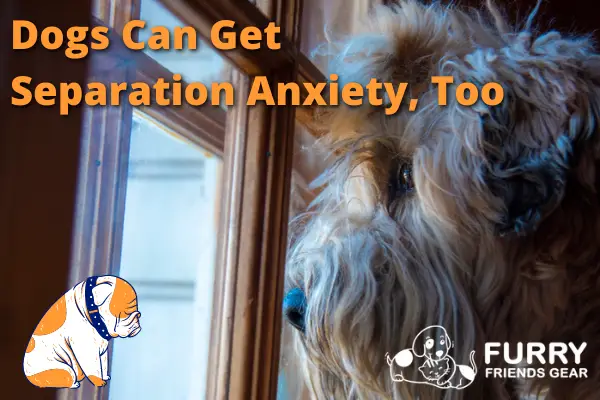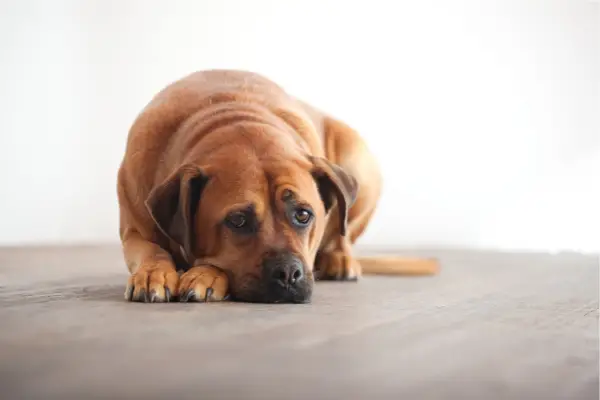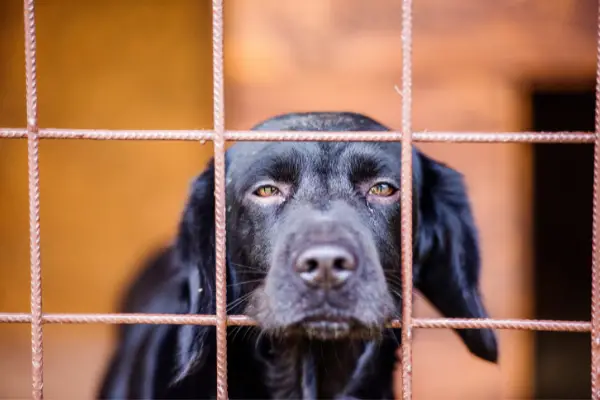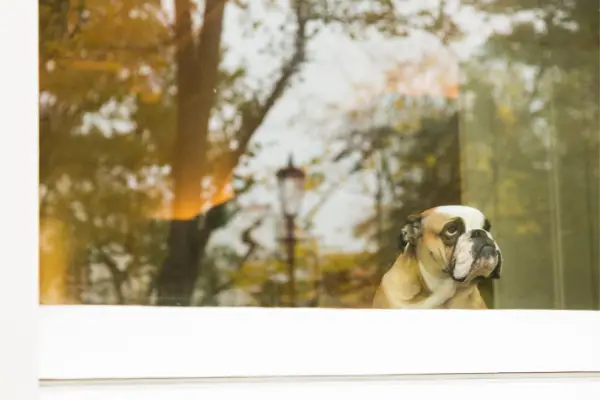
As dog owners, you might be familiar with this scene - things scattered everywhere, toys chewed, pee on the corner - this is probably one of the scenes you are greeted with by the time you get home from work. And as much as we love our dogs, this can be very frustrating.
Most dog owners complain about how destructive their dogs are no matter what training they give their dogs. What most dog owners don’t know is that some of these behaviors can’t be solved by house training alone.
Without you knowing, your dog might already be suffering from separation anxiety and you might have to learn how to help a dog with separation anxiety.

What Is Separation Anxiety?
Separation anxiety is when a dog, puppy, or adult, starts to exhibit signs of stress every time you leave. Particularly the person is someone they’re very close with. Symptoms may vary, but one thing in common is that dogs feel terrified when they’re alone.
Below, we present to you several ways how to help a dog with separation anxiety. But before we get to that, let us first take a look at the symptoms and what could be causing your dog’s separation anxiety.
Symptoms of Separation Anxiety
Symptoms of separation anxiety may vary from one dog to another. What you think might be something that can be solved with house training is already a sign of separation anxiety. Here are some symptoms to watch out for:
Urinating or Defecating in the House
Let’s say your dog is well-trained in terms of using the bathroom. However, for some reason, he decided to pee or go potty in your home while you're away. This is already a sign of separation anxiety.
But don’t make any conclusions yet. If your dog pees while in front of you, this may not be a symptom. It can also be a medical condition that lets them do this, so it’s better to get them checked with a vet first.
Excessive Barking, Howling, or Whimpering
Another symptom to watch out for is when your dog is excessively barking or howling. This is a way for your dog to tell you that they feel lonely. If not taken care of, this can be a problem not only for you but also for your dog and neighbors.
Other than barking, your dog may also whimper when you or his designated guardian is not around. He may also act scared while being at the corner or while pacing.
Destructive Behaviors
Destructive behaviors to watch out for in your dog are:
- Chewing on objects like shoes, pillows, clothing, and other household items.
- Biting the door frames or window sills.
- Scratching the floor at the doors and doorways.
- Destroying household items.
These are all things you should be aware of if you want to know how to help a dog with separation anxiety. If you came home and opened the door to see all the destruction, then your dog was probably too upset when you left. However, when they do this while you’re at home, it can actually be something you can solve by house training your dog.
Trying to Escape
Another obvious way your dog will show separation anxiety is when he tries to escape. They may scratch the doors and windows just to get out of the house. This is very troublesome as they can injure themselves in the process. They can break their teeth, cut and scrape their paws, or even damage their nails.
Pacing
Pacing is another symptom you would observe in a dog with separation anxiety. They usually trot on a fixed pattern, either moving back and forth or moving around in circles. Again, you would know it’s separation anxiety if he does this every time his guardian is not around.
Excessive Salivation, Drooling, or Panting
Lastly, some dogs also show excessive salivation, drooling, or panting when they’re stressed due to separation anxiety.

How To Help A Dog With Separation Anxiety And Its Causes
As the name implies, separation anxiety happens when a dog is separated from someone dear to them. There are several situations where dogs exhibit symptoms of separation anxiety. Below are some of them:
Being Left Alone for the First Time
Dogs love bonding with their owners. Sometimes, they even choose to stay close to just one person. That kind of closeness and bonding can trigger separation anxiety once they’re left alone for the first time.
Being Left Alone for Long Periods
Most of the time, dogs never get over the first time you leave them. That is why every time you leave for long periods, it worries them. Even if it’s just in a few hours like you going to the office, most especially if you’re going on a trip that will last for a few days.
Traumatic Event
Some dogs have experienced being abandoned by their dog owners, and this is what causes separation anxiety. You leaving him can trigger this memory, making him feel scared and worried that maybe you won’t come back. This is very common for dogs left in shelters or pounds by their previous owners.
New Caretaker
Again, dogs form bonds with their owners. And though most dogs connect bonds with every family member, there are dogs that only bond with one person. Separation anxiety then occurs if your dog is introduced to someone new to take care of him. He would feel abandoned by his previous caretaker.
Change in His Routine or Schedule
A keying to understanding how to help a dog with separation anxiety is to know of any change in your dog’s routine or schedule can also cause separation anxiety, particularly during time periods. Like if your dog is used to being with you from 8-11 am and then the next week you have to go somewhere at a much different time of day, your dog will feel that and will be confused about why you’re not with him during that time of the day.
Moving into Another Residence
When you move to a new location, knowing how to help a dog with separation anxiety is important. Moving to another residence can cause separation anxiety. In your new home, a lot can change. There's a new environment, new schedule, new room, etc. These can all be very overwhelming to your dog.
New Member in the Household
An additional member in your home can also cause separation anxiety. For example, you're a parent and you’re really close to your dog, but then you also had a new baby. Of course, you would need to take care of your baby. This may give you lesser time to take care of your dog. And though you don’t mean to do it, it might make your dog sad.
Someone in the Household is No Longer There
Just like when a new member is introduced, losing someone in the family is another cause of separation anxiety. This is most especially if your dog is really close to the person who’s gone.

How To Help A Dog With Separation Anxiety: Tips and Tricks
As you can see, a lot can cause separation anxiety for your pets, and it can manifest in different ways. If not taken care of, a mild symptom can become problematic.
You should remember, though, that separation anxiety is not something you can treat easily. It will take time, and it will need your patience.
Below, we discuss some things you can do so that you understand how to help a dog with separation anxiety:
1. Build Your Dog’s Tolerance for Alone Time
One of the simplest ways to treat your dog’s separation anxiety is to build his tolerance for being alone. This means gradually increasing the time your dog is left alone by letting your dog not come near you all the time.
For example, you and your dog are together in one room. Pet your dog and speak to him softly before leaving him alone. You mustn’t tell him that you’re going. Leave the room, close it, and try to observe what your dog will do.
If he’s going to cry and go wild, just let him. It’s probably better if you try to remove any item that he might possibly destroy there. You can wait until your dog calms down, or just stick to 15 minutes first if you want. If the anxiety is severe, do this for only 20 seconds and gradually increase it.
When you get back, don’t act excited. Stay calm, and only reward your dog once he calms down. You can also leave your dog a toy inside the room or lots of treats, so he feels that being alone is not that bad.
Do this daily while gradually increasing the amount of time you’re separated from your dog. This is one way that you know how to help a dog with separation anxiety. But, make sure to do it once a day only to add stress to your dog.
2. Teach Your Dog To Become Independent
The next thing you should do is to teach your dog to become independent. Don’t let your dog follow you around constantly, especially when you’re preparing to leave.
It will also help if you don’t entertain any attention-seeking behaviors like whining. This might sound mean and will make your dog lonely, but this is very important. Besides, you can always schedule playtime, but don’t play with your dog while you're busy only because he wants to.
3. Change Your Going Away Signals
As you’re doing certain behaviors before leaving, your dog starts to get familiar with this. You getting your purse can be a signal. You going out of the main door is also a signal.
To know how to help a dog with separation anxiety, you should make some changes in your going out routine to help reduce your dog’s stress for being left alone again. For example, if you’re used to wearing your coat and leaving, why not wear your coat but don’t go yet. You can also leave your keys and purses in a different location every day.
This will help break your dog’s association of these objects with you leaving, and it really helps keep your dog calm.
4. Be Calm When Arriving or Leaving Your Dog
As dog owners, we all have that tendency to become overly dramatic when we leave our homes or even when we arrive. But, little do we know that this creates a very negative feeling for our fur babies. This just makes your dog fear being alone more because they can feel that you’re worried about them.
So instead, you should stay calm. Don’t make a big deal out of your leaving, and don’t be too overexcited when you come back home. Don’t play with your dog immediately. Wait until he calms down before petting him and giving him a treat.
5. Take Your Dog Out For An Exercise
Next, you can tire your dog out before leaving. A tired dog is usually a calm dog. This also helps as a distraction because, by the time you get home, your dog will be more focused on eating or sleeping instead of you going out. It also gives them a feeling of contentment because both of you already spent time together.
6. Feed Your Dog Before Leaving
You should also not forget about feeding your dog before you leave. Just like with exercise, it helps in making your dog feel content and relaxed. Other than that, don’t forget to leave treats around the house for your dog to find while you’re away.
7. Leave Some Toys
If your dog has a particular toy that he loves, leave it in an area for him to see. This will help keep your dog company while you’re away. It’s also a great way to entertain and keep him happy.
8. Hire a Dog Walker
If you’re going away for a few days, you should definitely hire a dog walker. Someone that you can trust, probably a neighbor or your friend. This is especially important if your dog is not yet used to you going away for too long.
9. Create Some Personal Space
Lastly, create some personal space. As much as possible, give him a separate bed when it’s time to sleep. Provide him his own couch, so he’s not always with you. This way, your dog will learn to value alone time. Once your dog can follow this, don't forget to give a treat, pet him, or praise him for doing a good job.
Related article: Best Dog Toys for Separation Anxiety
How To Help A Dog With Separation Anxiety: When To Seek Professional Help
If everything above doesn't work, then perhaps it’s time to seek professional help. Veterinarians are the best people who can figure out what your dog needs to cope with this problem. They might even provide calming aids and other medications.

Conclusion
Separation anxiety should not be treated simply. It can turn from mild to serious if not taken care of. So, if you think your dog has one, it’s best that you really pay attention and start the following ways to help your dog with it.
This is very common for adopted dogs because they have experienced loss already. You need to make your dog feel loved and always remind him that you will never leave him.
https://www.furryfriendsgear.com/how-to-help-a-dog-with-separation-anxiety/?feed_id=186&_unique_id=62b0cd3524c34
No comments:
Post a Comment